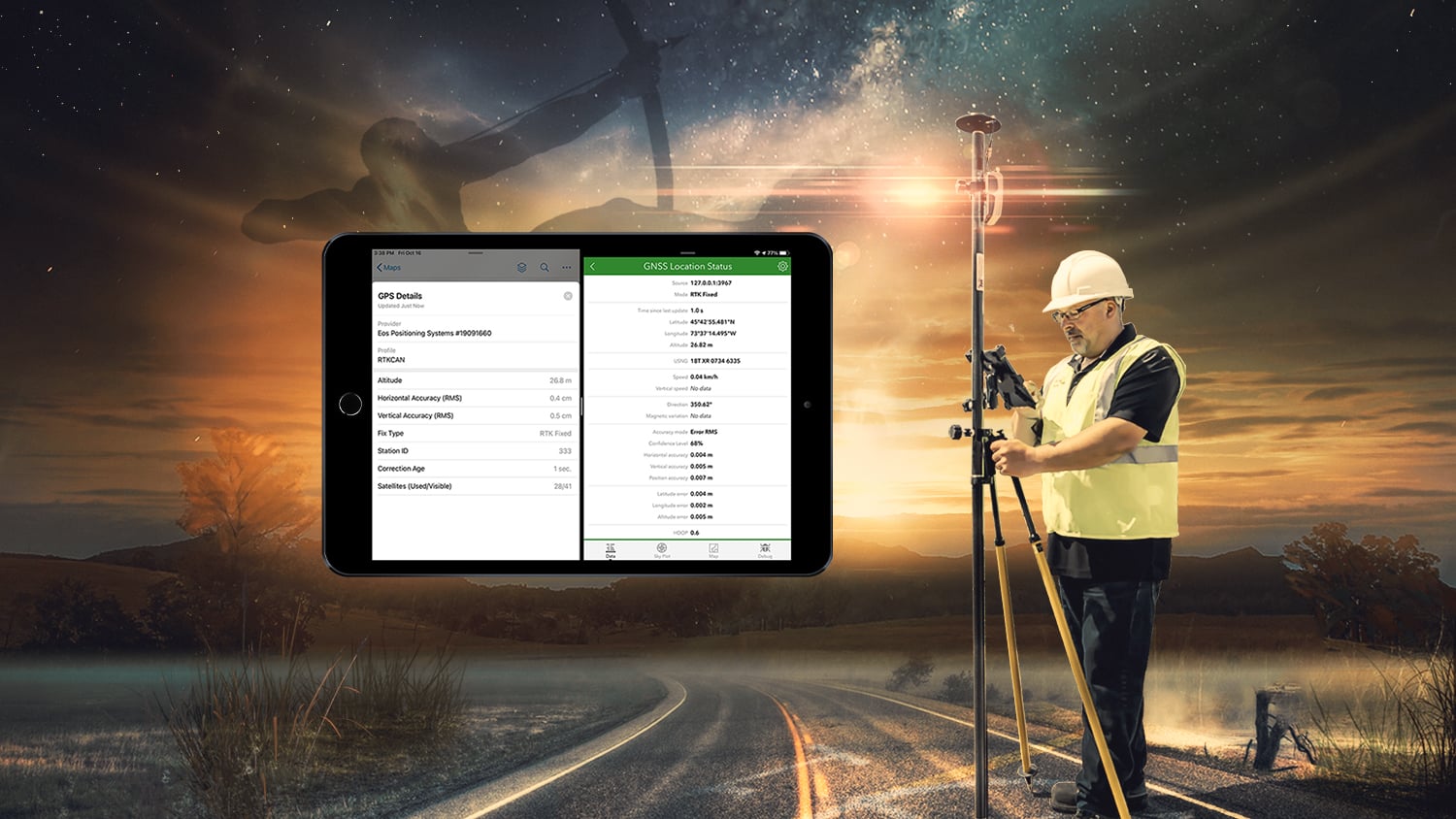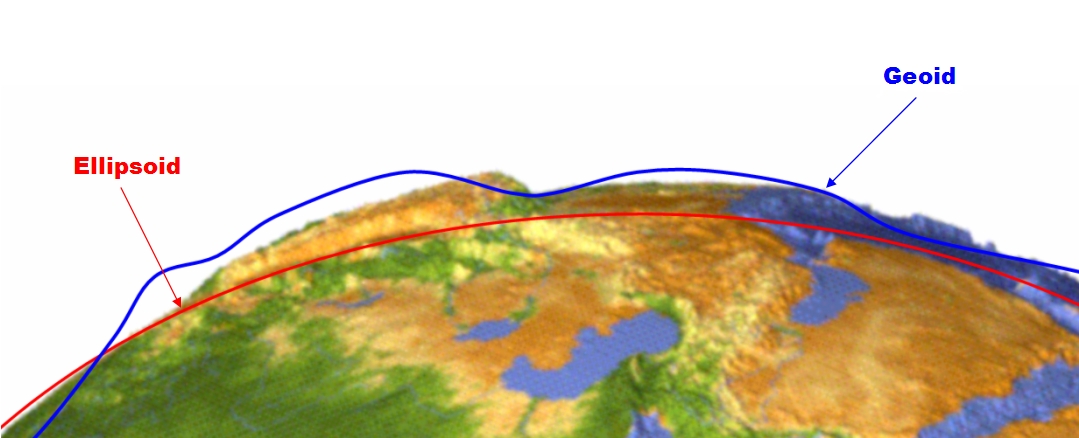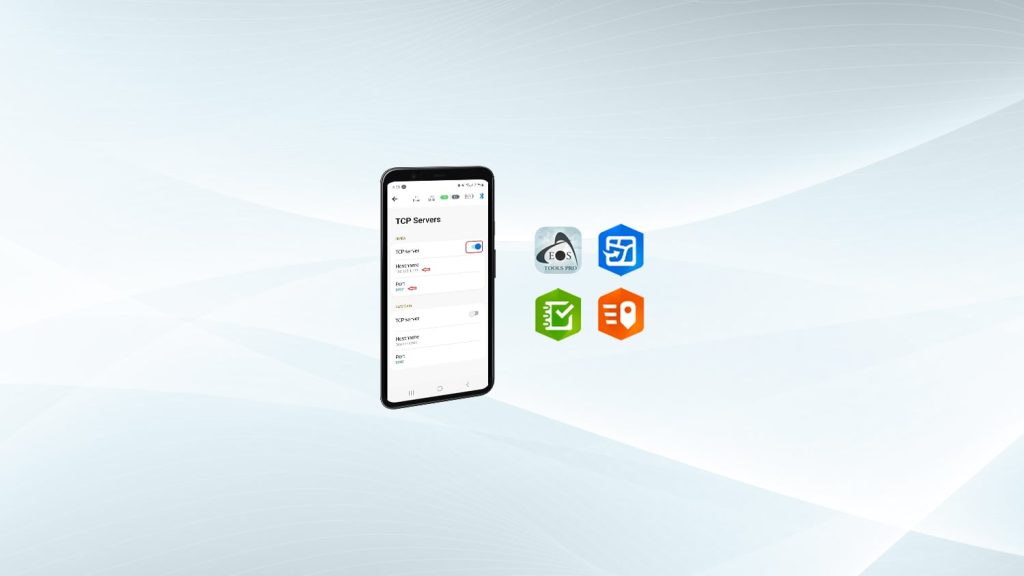Introduction:
In this article, you will learn how to consume the location data of your Arrow Series® GNSS receiver concurrently with multiple Esri ArcGIS mobile apps, on any iOS® device. This is achieved by using the new built-in TCP server feature of Eos Tools Pro. With this feature, Esri mobile data-collection apps (e.g., ArcGIS Collector or ArcGIS Field Maps, along with ArcGIS Survey123 and ArcGIS QuickCapture) can operate at the same time, on the same device, using location data from the same single Arrow GNSS receiver.
To perform the steps outlined in this guide to set up concurrent app usage, you must have Eos Tools Pro running on your iOS device.
Minimum technology requirements
You will need the following hardware devices:
- Arrow Series® GNSS Receiver (any model)
- iPhone®, iPad® or iPad mini*
*Note: The screenshots used in this article were taken on an iPad. The same steps apply to iPhone. The screenshots taken in the Collector/Field Maps chapter were taken on Collector but also apply to Field Maps.
You will need the latest iOS versions of the following apps:
- Eos Tools Pro – Download ETP from iTunes
- ArcGIS Collector – Download Collector from iTunes
- ArcGIS Survey123 – Download Survey123 from iTunes
- ArcGIS QuickCapture – Download QuickCapture from iTunes
- ArcGIS Field Maps – Download Field Maps from iTunes
There are a couple key concepts we would like to discuss before beginning the setup …
Important Concepts Before Beginning
Concept #1: Location Provider in Esri Mobile Apps
First, please make a note about the Location Provider differences with various Esri mobile apps. For instance: Survey123 and QuickCapture both feature a TCP client option within their Location Provider settings. However, Collector and Field Maps do not currently offer this option. Therefore, in the procedure described below, we will have either Collector or Field Maps connect directly to your Arrow GNSS receiver, while Survey123 and/or QuickCapture will utilize the TCP Server feature of Eos Tools Pro. Here is a summary of the correct Location Provider sources for each Esri mobile app used in this guide for concurrent usage:
-
- ArcGIS Collector: Use Location Provider directly from Arrow GNSS receiver
- ArcGIS FIeld Maps: Use Location Provider directly from Arrow GNSS receiver
- ArcGIS Survey123: Use Location Provider from TCP (Network)
- ArcGIS QuickCapture: Use Location Provider from TCP (Network)
Concept #2: Orthometric Heights
Please note: Any orthometric heights and/or datum shifts that you apply will also be reflected in Survey123 or QuickCapture. This happens via the TCP Server output of Eos Tools Pro.
Concept #3: Esri Mobile App Combinations that can Concurrently Consume Arrow Location Data
Here are all combinations of Esri mobile data-collection apps that can consume Arrow GNSS location data concurrently:
- ArcGIS Collector + ArcGIS Survey123
- ArcGIS Collector + QuickCapture
- ArcGIS Collector + ArcGIS Survey123 + QuickCapture
- ArcGIS Field Maps + ArcGIS Survey123
- ArcGIS Field Maps + QuickCapture
- ArcGIS Field Maps + ArcGIS Survey123 + QuickCapture
Please note: ArcGIS Collector and ArcGIS Field Maps cannot consume Arrow GNSS location data concurrently.
Concept #4: Important Considerations on Datum
Both Collector and Field Maps feature a “Location Profile” setting which allows you to define an on-the-fly datum transformation. Using this Location Profile, you can tell the Esri app to transform your Arrow GNSS coordinates to those of your ArcGIS Online published map.
Tip: Be sure to set Location Profile in Collector or Field Maps before beginning data collection.
Note that Survey123 and QuickCapture do not offer this feature. For data collected with Survey123 and QuickCapture, a datum transformation must be applied in ArcGIS if needed.
Step 1: Configure Eos Tools Pro
The first step is to install Eos Tools Pro on your mobile device and configure its TCP Server feature.
If you have not already, please download Eos Tools Pro here:
With Eos Tools Pro downloaded, follow these steps:
1. In your device’s Bluetooth settings, Bluetooth-pair your device with your Arrow GNSS receiver
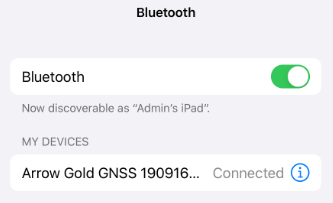
2. Check your Eos Tools Pro “TCP Server localhost” address and port number:
Launch Eos tools Pro.
Click on the (i) icon on the top right corner of Eos Tools Pro to open the About menu. Take note of both the TCP Server “localhost” address and port number (both shown below in red boxes).
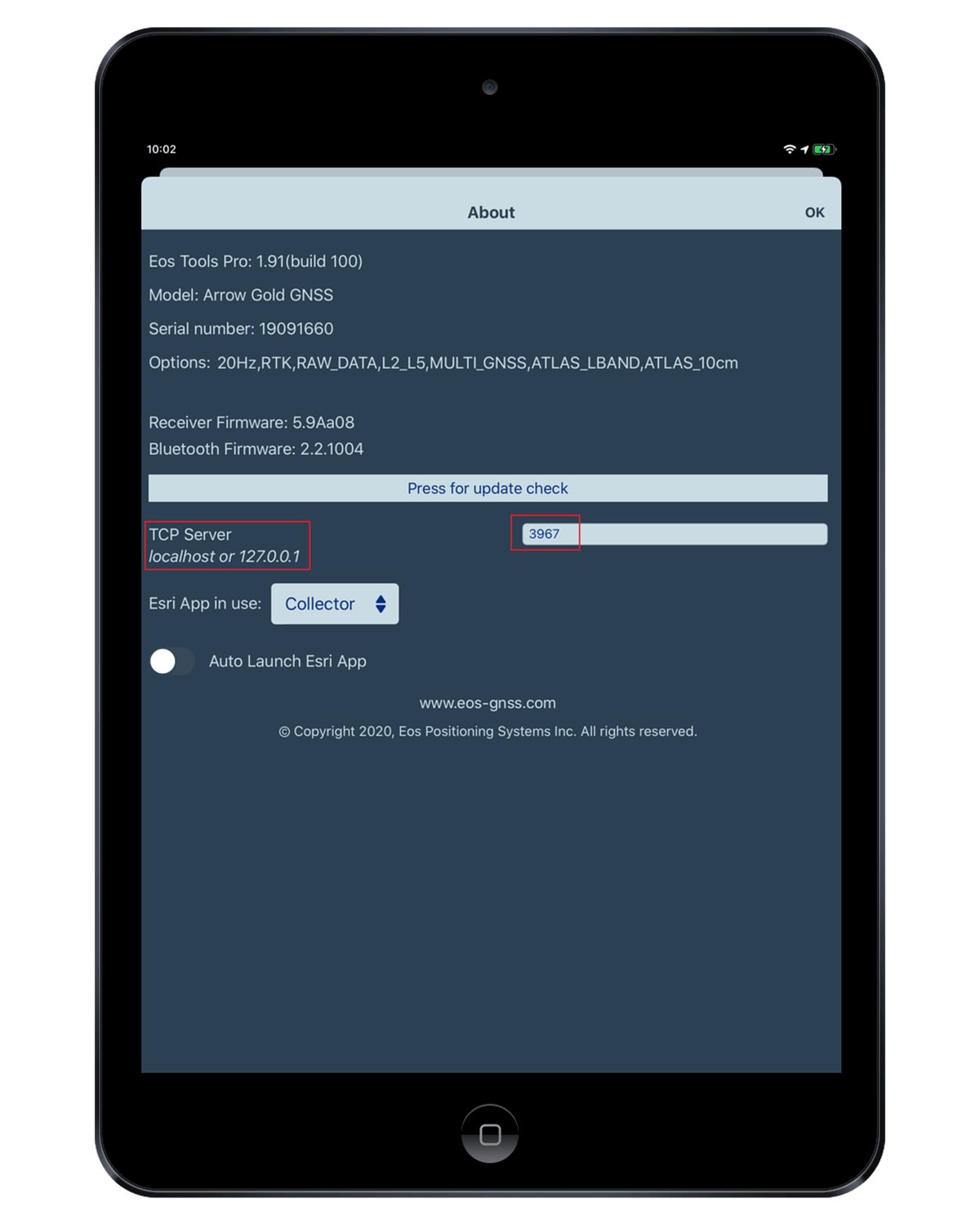
Tip 1: By default, the TCP Server localhost address is “127.0.0.1”; the port number is “3967”.
Tip 2: Eos Tools Pro’s TCP Server is always listening to incoming TCP-client connections at this combination of IP address and port number.
Important note: If you change the TCP port number, you will have to close and restart Eos Tools Pro for the change to take effect.
Step 2: Set Location Provider in ArcGIS Collector and ArcGIS Field Maps
Whether you are using ArcGIS Collector or ArcGIS Field Maps, they must be configured to read the location information directly from the Arrow. This configuration takes place within the Collector/Field Maps “Location Provider” settings.
To configure Location Provider within Collector/Field Maps, follow these steps:
1. Download Collector/Field Maps
Download and install Collector/Field Maps from the Apple App Store.
2. Launch app
Open Collector or Field Maps. Log in with your Esri ArcGIS Online account credentials.
3. Change the Esri app’s “Location Providers” setting
Navigate to the app’s “Settings” and then to “Location Providers.” The default should be “integrated,” indicating the app is reading your smartphone or tablet’s integrated GPS location.
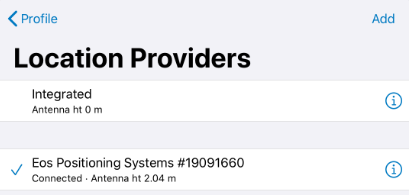
Tap “Add” in the top right corner. Next, from the list, select your Arrow GNSS receiver which you have already Bluetooth-paired to your device. Make sure to tap the Eos Positioning Systems Arrow GNSS receiver again, so that the check mark “sticks” on the Eos Arrow receiver and not on the “Integrated” location provider.
You have now successfully told Collector/Field Maps to read its location data from your external Arrow GNSS receiver. You may optionally complete any other settings you may need for your field work.
4. Verify Collector/Field Maps is reading location from the Arrow receiver
Within Collector/Field Maps, navigate to your desired ArcGIS Online web map, and open the map. You should see the “GPS accuracy” measurement displayed in sky-blue font at the top of the mobile screen.
If you tap on this estimated location accuracy, you will trigger a popup of GNSS location metadata from the Arrow GNSS receiver. If this step is successful, then you have properly configured the Collector/Field Maps mobile app to read locations from the Arrow GNSS receiver.
Once done, it is now time to configure your other Esri mobile apps (Survey123/QuickCapture) to read location data from your Arrow GNSS receiver using the “TCP Server” feature of Eos Tools Pro.
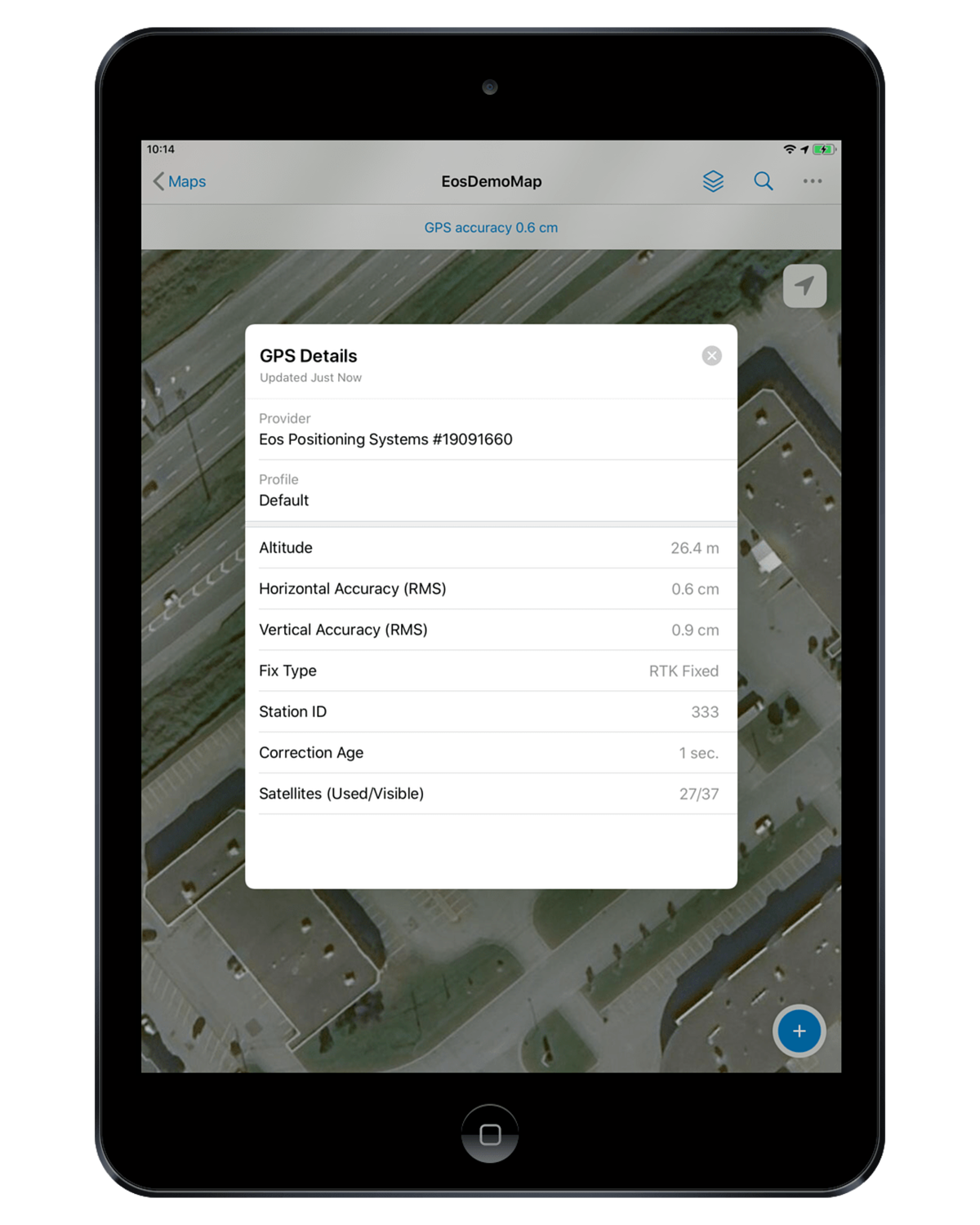
Step 3: Set Location Provider as “Network” in ArcGIS Survey123
The preferred location provider for Survey123, when used alone, is in fact the Arrow receiver. If you are using Survey123 and not concurrently using either Collector or Field Maps, we recommend setting the Survey123 Location Provider to your Eos Arrow GNSS receiver (similar to section #2).
However, when Survey123 is used concurrently with Collector or Field Maps — and when high-accuracy GNSS locations are required in both apps at the same time — then you must set the Survey123 “Location Provider” settings to “Network,” so that the app reads the TCP Server port from Eos Tools Pro.
Please note: When reading the location data from the TCP server of Eos Tools Pro, all GNSS metadata will be available, except for the Arrow model and serial number.
To configure TCP Server as the Location Provider within Survey123, follow these steps:
1. Download Survey123
2. Open Survey123
Open Survey123. Log in with your Esri ArcGIS Online account credentials.
3. Navigate to Location Providers → Network
Navigate to the Survey123 “Settings” menu, and then to “Location Providers”. You will see the “Integrated Provider” as a default.
Next, tap on “Add location provider” in the bottom left corner. Select “Network” within the list provided.
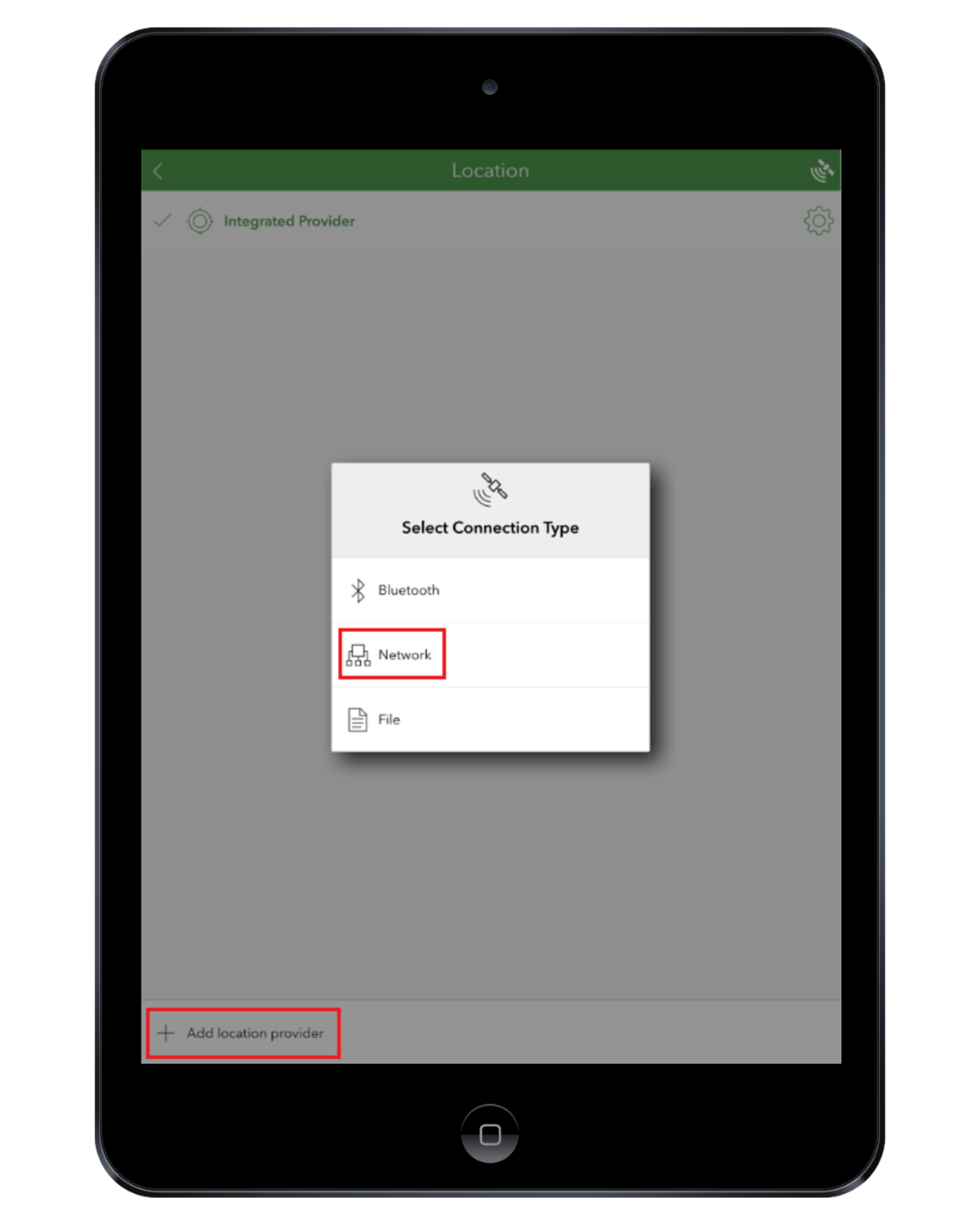
4. Enter Eos Tools Pro TCP Server information
You now need to enter the TCP Server localhost address and port number from Eos Tools Pro.
Under “Network Information” first enter your Eos Tools Pro TCP Server localhost address (this is most likely “127.0.0.1”) in the Hostname field.
Now, enter the port number.
For iOS users, this is most likely “3967”. Click the “Add” button within the Survey123 popup.
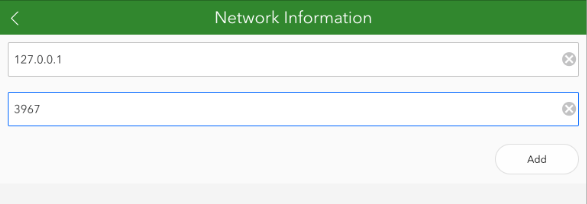
Congratulations! You have now set the Survey123 location provider to read from the TCP Server of Eos Tools Pro. At this point, you can complete any other relevant settings within Survey123.
5. Verify Settings
As soon as Survey123 is connected to Eos Tools Pro’s TCP Server, a satellite icon will appear on the top right corner of Survey123. Tap this satellite icon, and the Arrow GNSS receiver information will be displayed. If your screen looks similar to the one below, this confirms that Survey123 is now communicating properly with the Arrow’s TCP port.
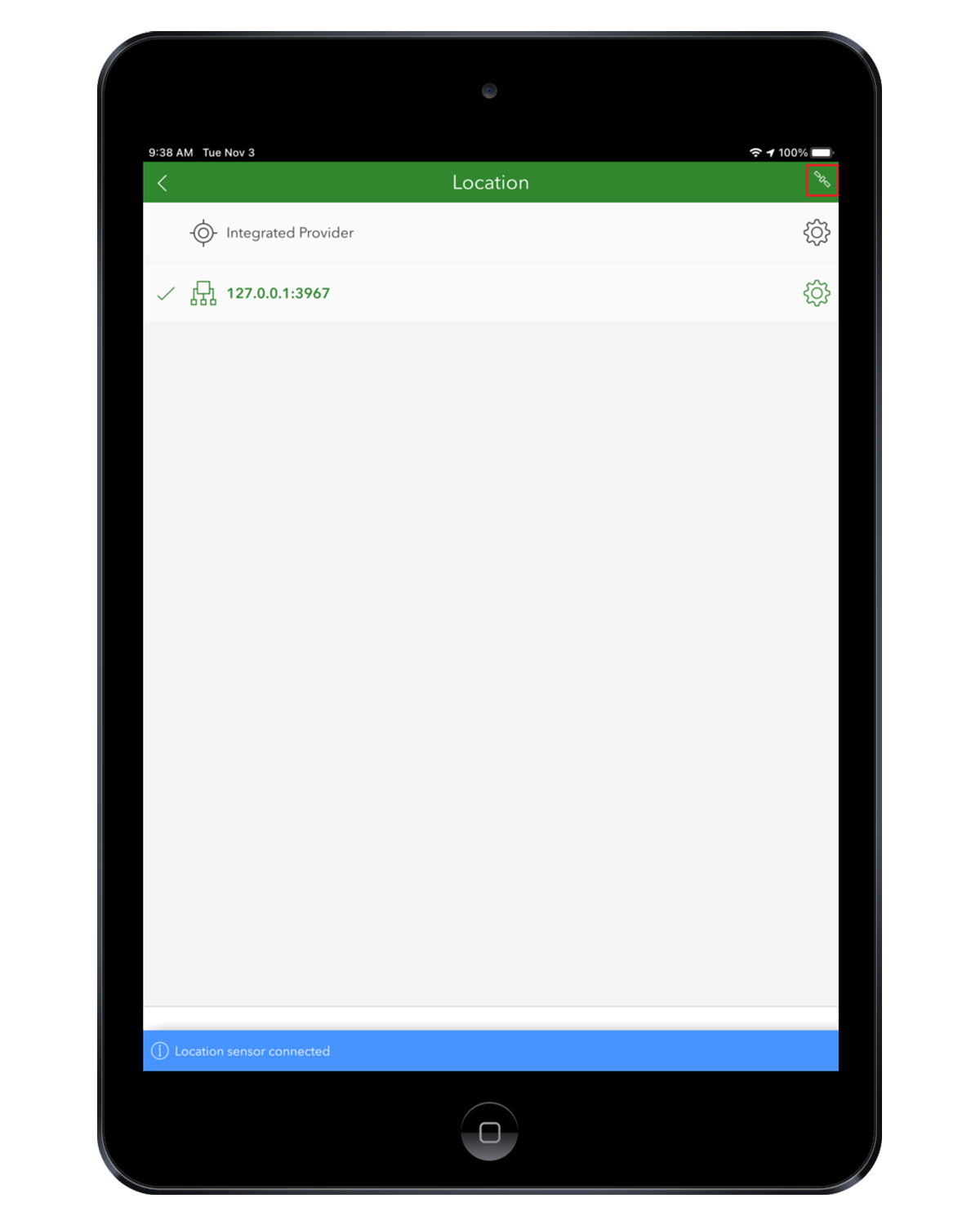
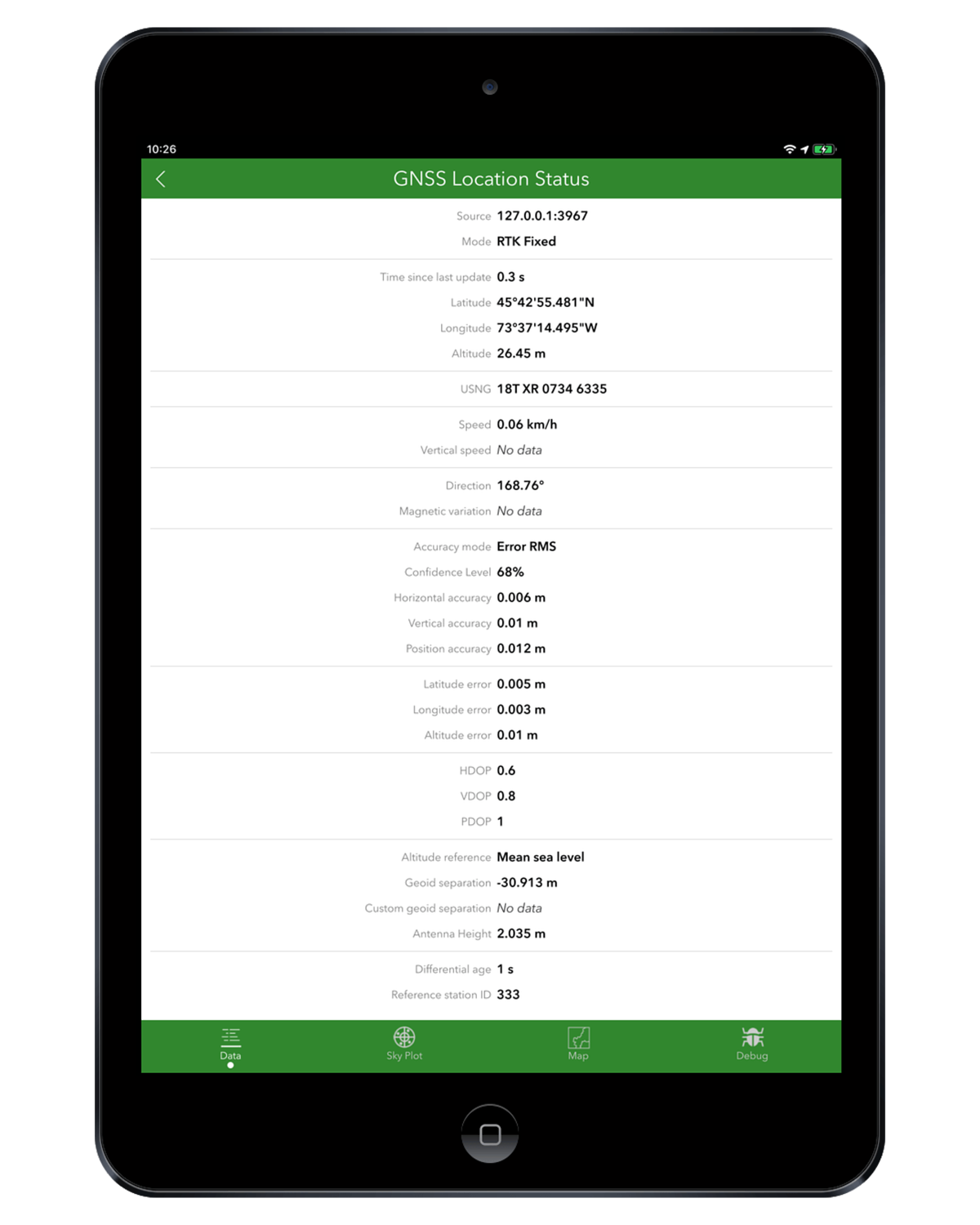
Step 4: Set Location Provider as “Network” in ArcGIS QuickCapture
Tip: Multiple apps that feature a network TCP client can concurrently use a TCP port. This is why both ArcGIS Survey123 and ArcGIS QuickCapture can simultaneously access the same Arrow GNSS location and metadata.
This section assumes you are using QuickCapture concurrently with either ArcGIS Collector or ArcGIS Field Maps for high-accuracy data collection. In this case, QuickCapture settings must have “Location Provider” set to read the Eos Tools Pro TCP Server. Once again (as in section 3.2), the only GNSS attribute metadata that will be missing is the Arrow model and serial number.
Here are the steps for configuring the TCP Server location provider to read Arrow GNSS location data in QuickCapture.
Please note: The preferred location provider for using ArcGIS QuickCapture alone is the Arrow receiver. If you are using QuickCapture and not concurrently using either Collector or Field Maps, we recommend setting the QuickCapture Location Provider to your Eos Arrow GNSS receiver.
1. Download ArcGIS QuickCapture
2. Open QuickCapture
Open QuickCapture. Log in with your Esri ArcGIS Online account credentials.
3. Navigate to Settings → Location Provider → Network
Navigate to QuickCapture’s Settings and then Location. You will see the “Integrated Provider” as a default. Tap on “Add location provider”. Select “Via Network” within the list.
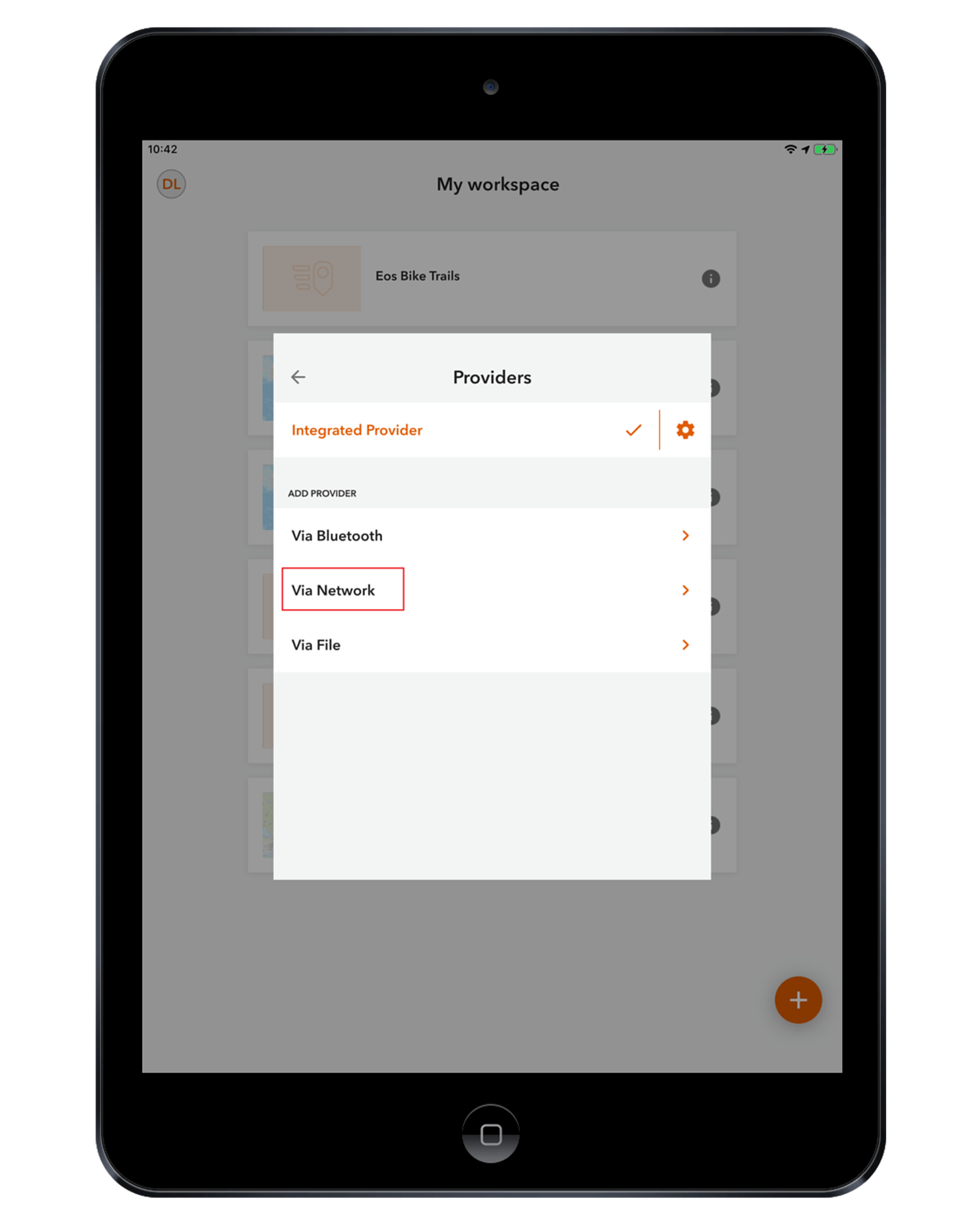
4. Enter Eos Tools Pro TCP Server information
You now need to enter the TCP Server localhost address and port number from Eos Tools Pro.
Under “Network Information” first enter your Eos Tools Pro TCP Server localhost address (this is most likely “127.0.0.1”) in the Hostname field.
Now, enter the port number. The default is “3967”.
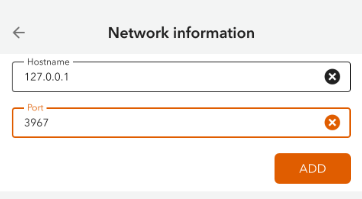
Click the “Add” button within the popup.
Congratulations! You have now set the QuickCapture location provider to read from the TCP Server of Eos Tools Pro. At this point, you can complete any other relevant settings to your data-collection workflow within QuickCapture.
5. Verify your Settings
Open your QuickCapture project, and you will see the GPS accuracy displayed at the bottom of the page. Tap on the little arrow, then tap on “View Information”. The Arrow GNSS Receiver information will be displayed — thus confirming that QuickCapture is properly receiving location data from your Arrow GNSS receiver.


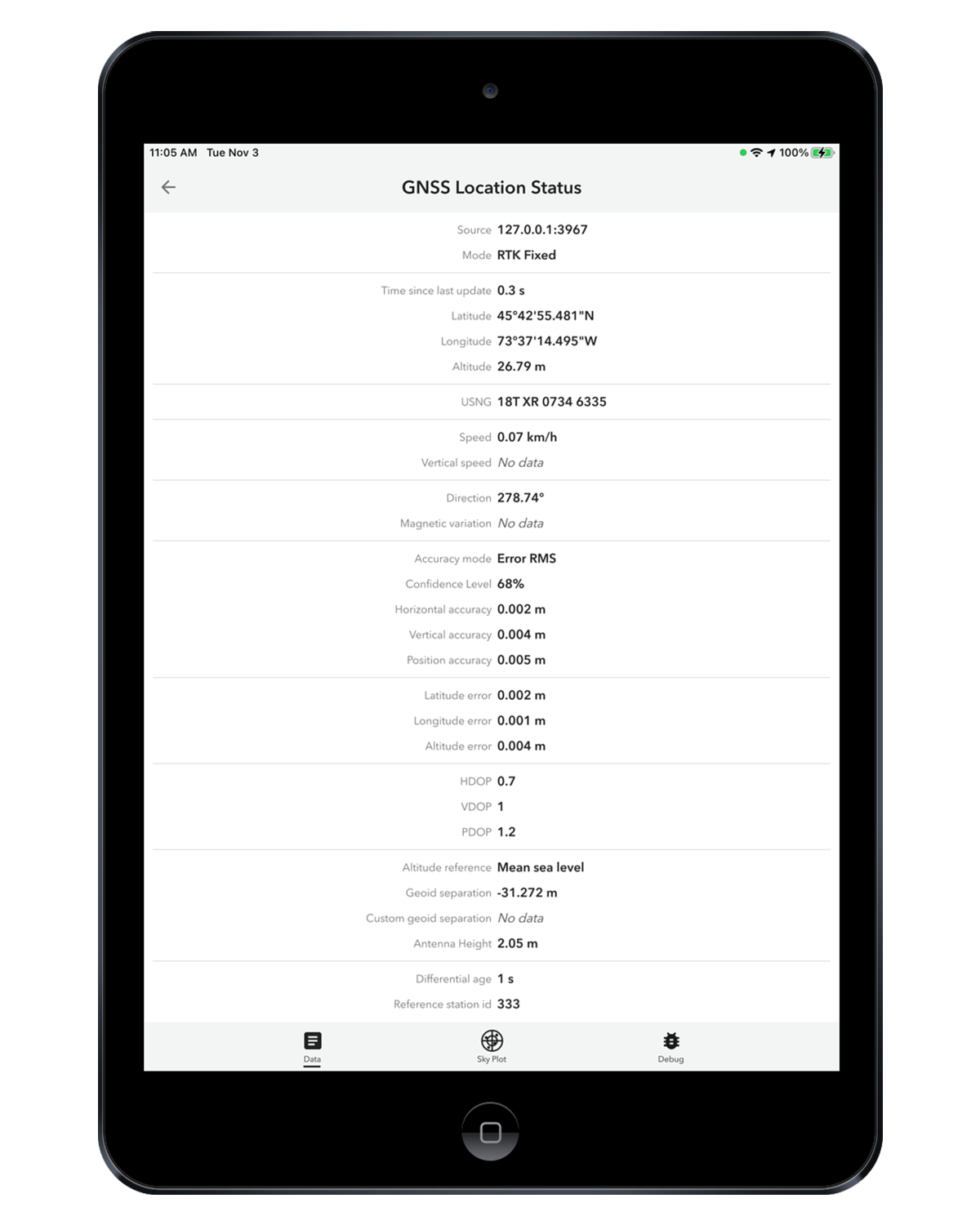
Conclusion
With these settings, you are now able to collect high-accuracy data in multiple Esri mobile apps that concurrently access location data from a single Arrow Series® GNSS receiver.

